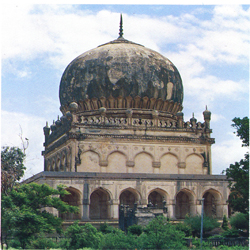 Daughter of Muhammad Quli Qutb Shah,the founder of Hyderabad.
Hayath Bakshi Begum was also the wife of Sultan Muhammad Qutb Shah and mother of Sultan Abdullah, the sixth king. She died in 1617.
Her beautiful tomb has a rectangular stone cistern in front with a fountain. There is a small mosque attached where Aurangzeb is said to have prayed during his Golconda campaign. A flight of steps leads up to the tomb’s extensive platform two metres above the ground. On it is an arcade of seven pointed arches on each side enclosing corridors. The main building is a quadrangular hall with fine minarets. Above this rises a splendid semi-circular dome set in a cup of lotus petals. At the top is a copper final. The corridor is 30 metres square and the shrine 19 metres square. The dome and corridor are of dressed granite cut in huge blocks, covered in parts with plaster and stucco in ornate designs. The doorways are also ornately made.
Adjacent to the tomb is a beautiful mosque, very richly ornamented with stucco work of a high order with entwining creepers and rosettes. The use of stucco as architectural decoration in India goes back to the ancient Buddhist times, to the 3rd century. Stucco covered temple and palace walls alike. It is certain that local Hindu artisans did influence Qutb Shahi architecture.
The grand mausoleum covering her remains show that Hayath Bakshi
Begum played a prominent role in palace politics. She was adored by her people and was addressed as ‘Ma Saheba’. Daughter of Muhammad Quli Qutb Shah,the founder of Hyderabad.
Hayath Bakshi Begum was also the wife of Sultan Muhammad Qutb Shah and mother of Sultan Abdullah, the sixth king. She died in 1617.
Her beautiful tomb has a rectangular stone cistern in front with a fountain. There is a small mosque attached where Aurangzeb is said to have prayed during his Golconda campaign. A flight of steps leads up to the tomb’s extensive platform two metres above the ground. On it is an arcade of seven pointed arches on each side enclosing corridors. The main building is a quadrangular hall with fine minarets. Above this rises a splendid semi-circular dome set in a cup of lotus petals. At the top is a copper final. The corridor is 30 metres square and the shrine 19 metres square. The dome and corridor are of dressed granite cut in huge blocks, covered in parts with plaster and stucco in ornate designs. The doorways are also ornately made.
Adjacent to the tomb is a beautiful mosque, very richly ornamented with stucco work of a high order with entwining creepers and rosettes. The use of stucco as architectural decoration in India goes back to the ancient Buddhist times, to the 3rd century. Stucco covered temple and palace walls alike. It is certain that local Hindu artisans did influence Qutb Shahi architecture.
The grand mausoleum covering her remains show that Hayath Bakshi
Begum played a prominent role in palace politics. She was adored by her people and was addressed as ‘Ma Saheba’.
|
|